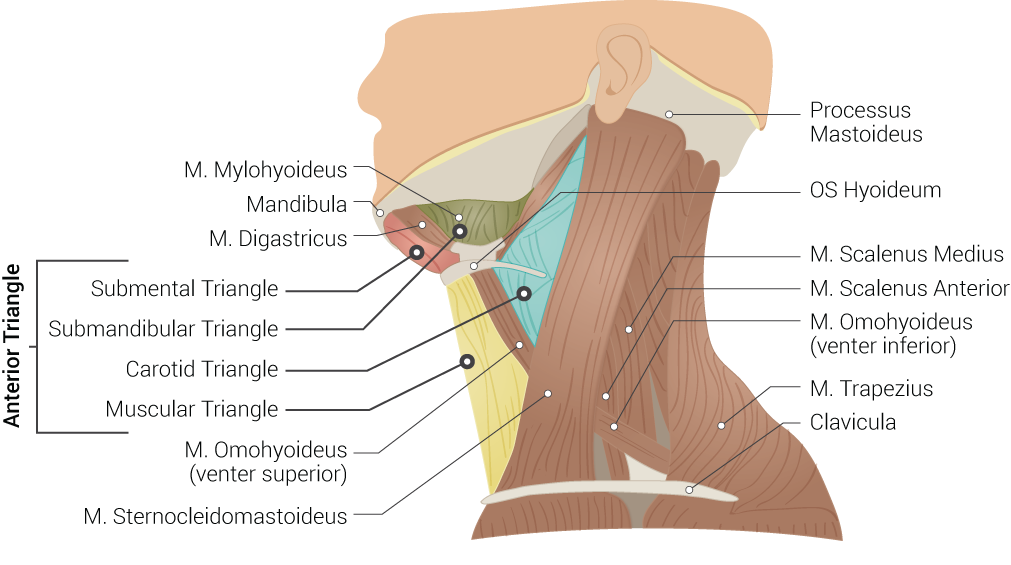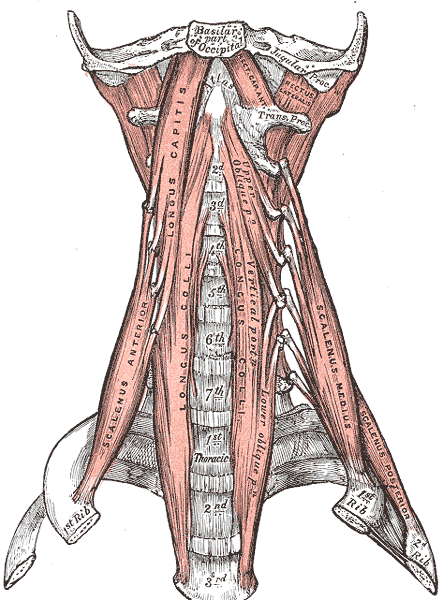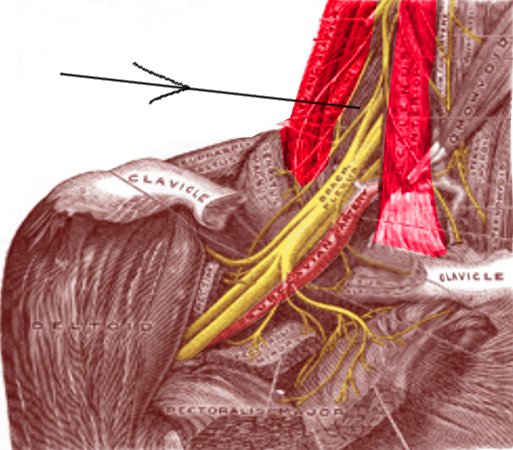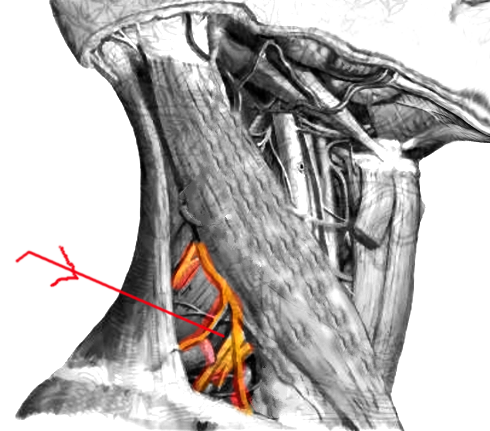[1]
Urschel HC, Patel A. Thoracic Outlet Syndromes. Current treatment options in cardiovascular medicine. 2003 Apr:5(2):163-168
[PubMed PMID: 12686013]
[2]
Kim HJ, Park SH, Shin HY, Choi YS. Brachial plexus injury as a complication after nerve block or vessel puncture. The Korean journal of pain. 2014 Jul:27(3):210-8. doi: 10.3344/kjp.2014.27.3.210. Epub 2014 Jun 30
[PubMed PMID: 25031806]
[3]
Dahlstrom KA, Olinger AB. Descriptive anatomy of the interscalene triangle and the costoclavicular space and their relationship to thoracic outlet syndrome: a study of 60 cadavers. Journal of manipulative and physiological therapeutics. 2012 Jun:35(5):396-401. doi: 10.1016/j.jmpt.2012.04.017. Epub 2012 May 17
[PubMed PMID: 22608284]
[4]
Chiti L,Biondi G,Morelot-Panzini C,Raux M,Similowski T,Hug F, Scalene muscle activity during progressive inspiratory loading under pressure support ventilation in normal humans. Respiratory physiology & neurobiology. 2008 Dec 31
[PubMed PMID: 18952011]
[5]
Theis S, Patel K, Valasek P, Otto A, Pu Q, Harel I, Tzahor E, Tajbakhsh S, Christ B, Huang R. The occipital lateral plate mesoderm is a novel source for vertebrate neck musculature. Development (Cambridge, England). 2010 Sep 1:137(17):2961-71. doi: 10.1242/dev.049726. Epub
[PubMed PMID: 20699298]
[6]
Connolly MR, Auchincloss HG. Anatomy and Embryology of the Thoracic Outlet. Thoracic surgery clinics. 2021 Feb:31(1):1-10. doi: 10.1016/j.thorsurg.2020.09.007. Epub
[PubMed PMID: 33220766]
[8]
Wijeratna MD,Troupis JM,Bell SN, The use of four-dimensional computed tomography to diagnose costoclavicular impingement causing thoracic outlet syndrome. Shoulder
[PubMed PMID: 27582945]
[9]
Ferreira SR, Martins RS, Siqueira MG. Correlation between motor function recovery and daily living activity outcomes after brachial plexus surgery. Arquivos de neuro-psiquiatria. 2017 Sep:75(9):631-634. doi: 10.1590/0004-282X20170090. Epub
[PubMed PMID: 28977143]
[10]
Hamada T, Usami A, Kishi A, Kon H, Takada S. Anatomical study of phrenic nerve course in relation to neck dissection. Surgical and radiologic anatomy : SRA. 2015 Apr:37(3):255-8. doi: 10.1007/s00276-014-1343-1. Epub 2014 Jul 16
[PubMed PMID: 25026999]
[11]
Safran MR. Nerve injury about the shoulder in athletes, part 2: long thoracic nerve, spinal accessory nerve, burners/stingers, thoracic outlet syndrome. The American journal of sports medicine. 2004 Jun:32(4):1063-76
[PubMed PMID: 15150060]
[12]
Qaja E,Honari S,Rhee R, Arterial thoracic outlet syndrome secondary to hypertrophy of the anterior scalene muscle. Journal of surgical case reports. 2017 Aug;
[PubMed PMID: 28928918]
Level 3 (low-level) evidence
[13]
Aboul Hosn M, Goffredo P, Man J, Nicholson R, Kresowik T, Sharafuddin M, Sharp WJ, Pascarella L. Supraclavicular Versus Transaxillary First Rib Resection for Thoracic Outlet Syndrome. Journal of laparoendoscopic & advanced surgical techniques. Part A. 2020 Jul:30(7):737-741. doi: 10.1089/lap.2019.0722. Epub 2020 May 15
[PubMed PMID: 32412829]
[14]
Abdel Ghany W, Nada MA, Toubar AF, Desoky AE, Ibrahim H, Nassef MA, Mahran MG. Modified Interscalene Approach for Resection of Symptomatic Cervical Rib: Anatomic Review and Clinical Study. World neurosurgery. 2017 Feb:98():124-131. doi: 10.1016/j.wneu.2016.10.113. Epub 2016 Oct 28
[PubMed PMID: 27989967]
[15]
Lee GW, Kwon YH, Jeong JH, Kim JW. The efficacy of scalene injection in thoracic outlet syndrome. Journal of Korean Neurosurgical Society. 2011 Jul:50(1):36-9. doi: 10.3340/jkns.2011.50.1.36. Epub 2011 Jul 31
[PubMed PMID: 21892402]
[16]
Yan Z,Chen Z,Ma C, Liposomal bupivacaine versus interscalene nerve block for pain control after shoulder arthroplasty: A meta-analysis. Medicine. 2017 Jul;
[PubMed PMID: 28682872]
Level 1 (high-level) evidence
[17]
Feigl GC, Litz RJ, Marhofer P. Anatomy of the brachial plexus and its implications for daily clinical practice: regional anesthesia is applied anatomy. Regional anesthesia and pain medicine. 2020 Aug:45(8):620-627. doi: 10.1136/rapm-2020-101435. Epub 2020 May 28
[PubMed PMID: 32471922]
[18]
Borgeat A, Ekatodramis G, Kalberer F, Benz C. Acute and nonacute complications associated with interscalene block and shoulder surgery: a prospective study. Anesthesiology. 2001 Oct:95(4):875-80
[PubMed PMID: 11605927]
[19]
Gelabert HA, Rigberg DA, O'Connell JB, Jabori S, Jimenez JC, Farley S. Transaxillary decompression of thoracic outlet syndrome patients presenting with cervical ribs. Journal of vascular surgery. 2018 Oct:68(4):1143-1149. doi: 10.1016/j.jvs.2018.01.057. Epub 2018 Apr 25
[PubMed PMID: 29705086]
[20]
Camporese G, Bernardi E, Venturin A, Pellizzaro A, Schiavon A, Caneva F, Strullato A, Toninato D, Forcato B, Zuin A, Squizzato F, Piazza M, Stramare R, Tonello C, Di Micco P, Masiero S, Rea F, Grego F, Simioni P. Diagnostic and Therapeutic Management of the Thoracic Outlet Syndrome. Review of the Literature and Report of an Italian Experience. Frontiers in cardiovascular medicine. 2022:9():802183. doi: 10.3389/fcvm.2022.802183. Epub 2022 Mar 22
[PubMed PMID: 35391849]
[21]
Illig KA, Donahue D, Duncan A, Freischlag J, Gelabert H, Johansen K, Jordan S, Sanders R, Thompson R. Reporting standards of the Society for Vascular Surgery for thoracic outlet syndrome. Journal of vascular surgery. 2016 Sep:64(3):e23-35. doi: 10.1016/j.jvs.2016.04.039. Epub
[PubMed PMID: 27565607]
[22]
Ajalat MJ, Pantoja JL, Ulloa JG, Cheng MJ, Patel RP, Chun TT, Gelabert HA. A Single Institution 30-Year Review of Abnormal First Rib Resection for Thoracic Outlet Syndrome. Annals of vascular surgery. 2022 Jul:83():53-61. doi: 10.1016/j.avsg.2021.12.080. Epub 2022 Jan 6
[PubMed PMID: 34998937]
[23]
Ciampi P, Scotti C, Gerevini S, De Cobelli F, Chiesa R, Fraschini G, Peretti GM. Surgical treatment of thoracic outlet syndrome in young adults: single centre experience with minimum three-year follow-up. International orthopaedics. 2011 Aug:35(8):1179-86. doi: 10.1007/s00264-010-1179-1. Epub 2010 Dec 24
[PubMed PMID: 21184222]
[24]
Povlsen S, Povlsen B. Diagnosing Thoracic Outlet Syndrome: Current Approaches and Future Directions. Diagnostics (Basel, Switzerland). 2018 Mar 20:8(1):. doi: 10.3390/diagnostics8010021. Epub 2018 Mar 20
[PubMed PMID: 29558408]
Level 3 (low-level) evidence
[25]
LaBan MM, Zierenberg AT, Yadavalli S, Zaidan S. Clavicle-induced narrowing of the thoracic outlet during shoulder abduction as imaged by computed tomographic angiography and enhanced by three-dimensional reformation. American journal of physical medicine & rehabilitation. 2011 Jul:90(7):572-8. doi: 10.1097/PHM.0b013e31821a70ff. Epub
[PubMed PMID: 21552107]




